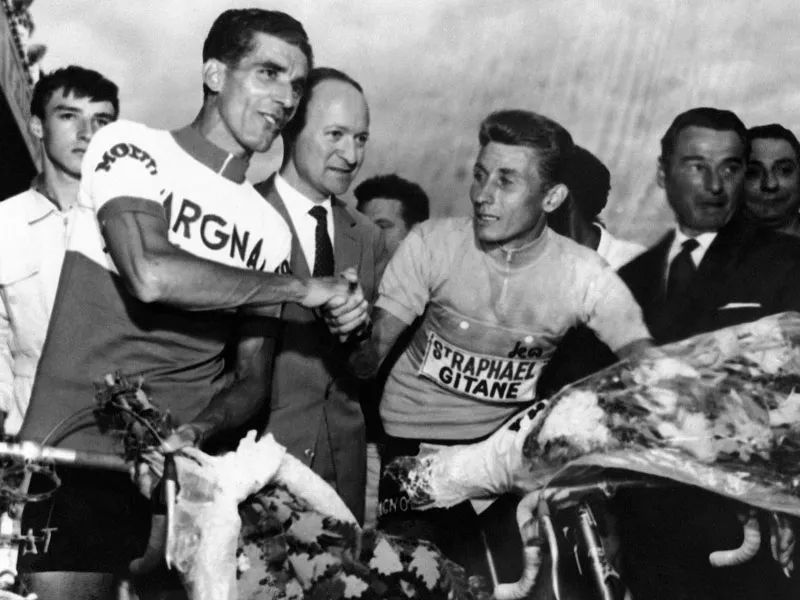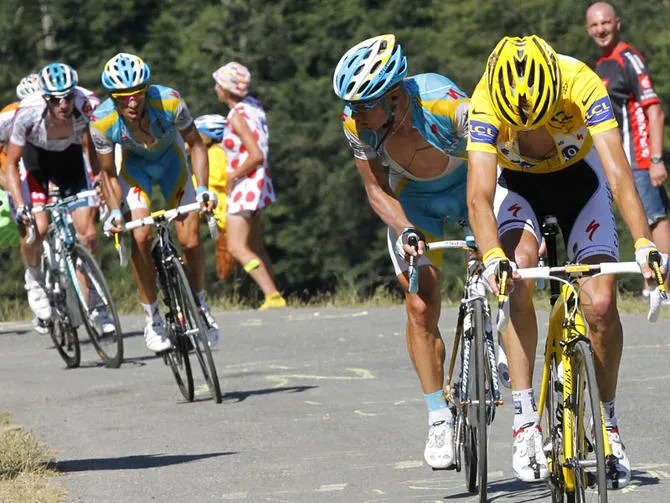There's a good chance that the old saying 'cheats never prosper' derives from the catalogue of foul play at the Tour de France.
The depths of skulduggery to which riders have gone down the years beggars belief, but the real surprise is how they expected to get away with it in the first place. Spiking bottles, wearing wigs, using lead-filled water bottles, catching trains – these stories only exist because the perpetrators were caught red handed.
Here, in no particular order, are our top 10 tales of those who stopped at nothing to get ahead in the biggest cycle race in the world.
1904
Only the second edition of the race and already riders were getting devious in what is still considered one of the most scandalous Tours of all time. Fines were handed out for all kinds of rule-breaking, from riding in the slipstreams of cars to getting tows from cyclists who weren't even in the race. And while fans play a role in racing to this day, it's never to the extent of 1904, when hundreds of breakaway stage leader André Fauré's fans blocked the path of the rest of the peloton.
In total, nine riders were disqualified during the race for illegal action, which even extended to catching trains and hitching lifts in cars. Complaints about the latter from other cyclists eventually resulted in the disqualification of every stage winner, plus the top four finishers, though the exact reasons were never officially made public.
1978
We've tried to steer clear of doping stories here, mainly because there's a list of them longer than our arm but also because they're often rather humourless. However, the story of former Belgian national champion Michel Pollentier is so outlandish that we just have to include it.
After winning the stage to Alpe d’Huez and taking the yellow jersey, Pollentier used an elaborate system of tubes (and a condom) to fool doping controllers. Filling the condom with someone else's urine, he held it in his armpit and ran a tube down his shorts to give the impression he was passing water himself.

Pollentier must have feared what was coming when he entered doping control
He would have got away with it had it not been for another pesky rider, who aroused suspicion by running into bother with his own cheating system. The doctor demanded that Pollentier lift his own jersey, giving the game away in slapstick fashion.
1963
Jacques Anquetil is a bona fide Tour de France legend but even he wasn’t beyond a bit of foul play. In his day, the rules didn’t permit riders to change bikes unless they had a mechanical problem. So when the Frenchman’s team director Raphael Geminiani thought he could do with a lighter bike for the Col de la Forclaz, for stage 17, he told a mechanic to cut through a gear cable, claiming that it had snapped.

Eventual runner-up Bahamontes congratulates Anquetil after the Frenchman notched his third consecutive Tour win in 1963
The bikes were switched back at the summit and Anquetil snatched a sprint victory over big rival Federico Bahamontes, catapulting himself to the top of the GC on his way to his fourth Tour crown. The rule about swapping bikes was scrapped ahead of the race in 1964.
1913
It would be harsh to call Eugène Christophe a cheat for this incident, but it’s well worth repeating. The Frenchman was set for Tour victory when his fork snapped on the descent into Sainte-Marie-de-Campank. He walked more than 10km to the town with his bike over his shoulder, where a young girl led him to a blacksmith.
Back then, riders were responsible for their own repairs, so Christophe set about fixing the fork himself, with guidance from the blacksmith. However, he was subsequently penalised because he’d allowed a boy to pump the bellows for him. Filling his pockets with bread, he scaled two more mountains alone before finishing the Tour in seventh. They don't make them like they used to.
1911
Race favourite Paul Duboc collapsed midway through stage 10, allegedly as a consequence of food poisoning from a spiked bottle. At the time, the perpetrator was thought to be Duboc's big rival Gustave Garrigou.
Bad feeling among fans was so fevered that when the race passed through Duboc's home town of Rouen, race organisers disguised Garrigou in a wig and dark glasses to get him through unscathed. These days, many people think climber Francois Lafourcade was more likely to have been responsible.
2010
While not everyone's idea of cheating, Alberto Contador's attack on race leader Andy Schleck, after the Luxembourg rider had slipped his chain on stage 15's climb of Port de Bales, is one of the biggest non-doping controversies of recent times.
It divided opinion among the sport's legends and, while many argued that all is fair in bike racing, it was the Spaniard's claim that he'd been unaware of the mechanical that left a sour taste for many. Schleck eventually lost 39 seconds to Contador on the stage – ironically, it was the same margin that Contador took the overall win by in Paris.

The 'chain gate' moment: does Contador's explanation check out?
Revenge, while not exactly sweet, would be Schleck's 18 months later, when Contador was stripped of his title – a random drug test during the 2010 race's second rest day had found clenbuterol in his system. Schleck belatedly accepted the yellow jersey during a ceremony in 2012.
1960
Tragedy struck in the 1960 Tour, when Frenchman Roger Rivière overshot a bend on the Col de Perjuret in pursuit of rival Gastone Nencini, falling into a ravine and breaking his back. He pinned the blame on his team mechanic, saying his brakes hadn't been working and then accusing him of leaving oil on the wheels.
But doctors soon found the real reason for the crash – a volume of painkillers in Rivière’s blood so high that his hands were too slow to operate the brakes. He would later confess to being a drug addict.
1905
After he punctured just a few kilometres into the seventh stage to Bordeaux, Louis Trousselier's rivals sped away, leaving him with the prospect of 200 solo kilometres. He ended up winning the stage with a sprint finish, but the fury that drove him there was overshadowed when he reportedly smashed the inkstands his fellow competitors were going to use to sign in.
1953
The 'sticky bottle' technique – riders taking pulls from team cars by holding on to bottles held by managers – has become the acceptable face of cheating these days. But Jean Robic's apparent heavy bottle of 1953 was a little more sinister.
Not known for his descending, the featherweight Frenchman is said to have taken on a lead-filled water bottle at a mountain summit, helping him to sink like a stone on the way back down. He would get his comeuppance the following day, losing the yellow jersey in a crash that would later cause his withdrawal.
1906
The fourth Tour and it was the foul play of the spectators that influenced proceedings. Predating those who sabotaged the Etape Caledonia by more than a century, fans spread nails on the road, intent on helping their preferred rider. The cyclists weren't exactly angels either, with the train-catching indiscretions of 1904 repeated and four riders thrown out of the race.
